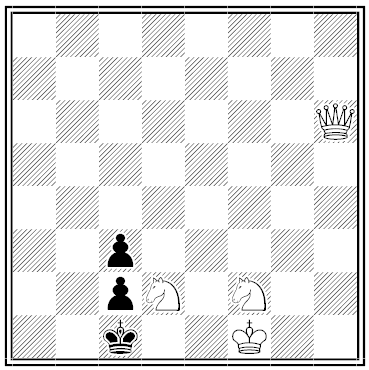
In 1908, two years before drawing against Emanuel Lasker for the world chess championship, Carl Schlechter published this problem in the Allgemeine Sportzeitung. White to mate in two moves:

In 1908, two years before drawing against Emanuel Lasker for the world chess championship, Carl Schlechter published this problem in the Allgemeine Sportzeitung. White to mate in two moves:
felicificability
n. capacity for happiness

Guidelines adopted by director Chuck Jones in making Warner Bros.’ Road Runner-Wile E. Coyote cartoons, from Jones’ 1999 memoir Chuck Amuck:
“The Road Runner and Coyote cartoons are known and accepted throughout the world,” Jones wrote. “Perhaps the lack of dialogue is one reason. If you want to laugh, you can do so at any time, whether in Danish, French, Japanese, Urdu, Navajo, Eskimo, Portuguese, or Hindi. ‘Beep-Beep!’ is the Esperanto of comedy.”
We were staying in Ballater, a small town on Deeside in Scotland. In the town was a tiny shop which sold tourist attractions and picture postcards, and in its minute window was a very fine specimen of smoky quartz material. Buying a postcard, I said to the proprietor, ‘That’s a fine group of smoky quartz in your window’ and had this reply in very broad Scotch:
‘That’s no smoky quartz, that’s topaz. It’s a crystal. You can tell crystals by the angles between their faces. If you’re interested I’ll lend you a book on the subject.’
I knew enough (crystals being rather in my line) to be sure it was smoky quartz, and on return to base looked up a book on Mineralogy which said ‘Smoky Quartz, also known as Cairngorm, is called Topaz in Scotland.’
— Sir W.L. Bragg, quoted in R.L. Weber, A Random Walk in Science, 1973
From J.A. Lindon in Recreational Mathematics Magazine, December 1962: If you advance I MUNCH BUN six places through the alphabet, you get O SATIN HAT:

Surely this means something.

On Feb. 11, 1979, 27-year-old Scott Moorman and four friends set out from Hana, Maui, for a daylong fishing expedition aboard the Sarah Joe, a 16.5-foot fiberglass motorboat. They did not return. The Coast Guard searched for five days, and private searches continued much longer, but no trace of them was found.
Nine and a half years later, in 1988, marine biologist John Naughton discovered a wrecked boat with Hawaiian registry on Taongi, the northernmost coral atoll in the Marshall Islands, 2,300 miles west of Hawaii. It was the Sarah Joe, and nearby, under a pile of stones and a driftwood cross, were the bones of Scott Moorman. How he came there, who buried him, and what became of the others remain unknown.
“I am willing to give you a show,
But are these all the rôles that you know?”
The manager cried.
And the actor replied,
“Sirrah! No, sir; I know ‘Cyrano’!”
There was a young lady of Butte,
Who thought herself very acute.
That her suitor might praise her,
She gave him a razor,
Which suited her suitor hirsute.
There was a nice fellow named Jenner,
Who sang a phenomenal tenor,
He had little to spend,
So I often would lend
The tenor a ten or a tenner.
‘Tis said, woman loves not her lover
So much as she loves his love of her;
Then loves she her lover
For love of her lover,
Or love of her love of her lover?
— From Carolyn Wells’ Book of American Limericks, 1925.

Published in 1961, the New English Bible was an attempt to translate the original Greek, Hebrew, and Aramaic texts of the Bible into modern English. Dwight MacDonald found this was “like finding a parking lot where a great church once stood.” As an illustration, he recast the Sermon on the Mount using only phrases that appear in the NEB:
When he realized how things stood, Jesus held a meeting to look into the matter. It was no hole-in-the-corner business. He went up the hill and began. ‘And now, not to take up too much of your time, I crave indulgence for a brief statement of our case. How blest are they that know they are poor. You are light for all the world. If a man wants to sue you for your shirt, let him have your coat as well. I also might make bold to say that you cannot serve God and money. Do not feed your pearls to pigs, and be ready for action, with belts fastened and lamps alight. Thanks for giving me a hearing.’ He then went to lunch with some distinguished persons.
“True, they did preserve ‘Jesus wept,'” MacDonald wrote. “But I’m sure there was strong support for ‘Jesus burst into tears.'”
In 1910 Frances Cornford published “To a Fat Lady Seen From the Train”:
O why do you walk through the fields in gloves,
Missing so much and so much?
O fat white woman whom nobody loves,
Why do you walk through the fields in gloves,
When the grass is soft as the breast of doves
And shivering sweet to the touch?
O why do you walk through the fields in gloves,
Missing so much and so much?
In 1927 G.K. Chesterton felt moved to reply:
Why do you rush through the field in trains,
Guessing so much and so much?
Why do you flash through the flowery meads,
Fat-head poet that nobody reads;
And why do you know such a frightful lot
About people in gloves and such?
“If a man could have half his wishes, he would double his troubles.” — Ben Franklin